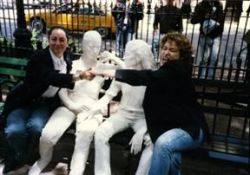Sheridan Square Viewing Garden
The Daily Plant : Monday, July 2, 2012
Gay Liberation Monument Celebrates 20th Anniversary

Photo taken by Jonathan Kuhn
Revelers at the Gay Pride Parade on Sunday June 24 thronged Sheridan Square and the Gay Liberation Monument. Saturday marked the 20th anniversary of the unveiling of the statuary group on June 23, 1992, but the story of the site-specific monument and events that inspired it go back much further.
The sculpture by George Segal (1924-2000) honors the gay rights movement and commemorates the uprising which took place at the Stonewall Inn opposite this park in Sheridan Square in 1969.
The Stonewall Inn was located at 51-53 Christopher Street, formerly two adjacent two-story stable houses erected in 1843 and 1846. Undergoing numerous alterations, and several incarnations, the inn reopened in 1967 as a “private club”—a bar and dance hall which, like numerous local establishments, catered to the vibrant gay community of Greenwich Village.
In the early hours of June 28, 1969 police raided the Stonewall Inn and a melee ensued in which thirteen people were arrested. Word of the raid and uprising soon spread, and the next day thousands gathered to protest the crackdown, and advocate for the legalization of gay bars. Further protests erupted in early July, and on July 27th a group of activists organized the first gay and lesbian march, from Washington Square to Stonewall. The events of that summer and their aftermath are often credited with launching the gay rights movement in the United States.
A decade later wealthy arts patron Peter Putnam (1927-1987), and trustee of the Mildred Andrews Fund commissioned the Gay Liberation monument. Putnam’s stewardship of the Fund had commissioned other contemporary sculptures, notably George Segal’s Kent State Memorial and Richard Hunt’s Harlem Hybrid. Though Segal was not the first artist approached, he accepted the commission, which stipulated only that the work “had to be loving and caring, and show the affection that is the hallmark of gay people…and it had to have equal representation of men and women.”
The proposed project met with rancor from all sides. A community board hearing was described by those present as one of the most contentious in memory. Petitions were gathered in opposition. Others felt that Segal’s conception was too tame, and called for a more strident artistic expression. A divided community board endorsed the project, as did the City’s Art Commission, but then the project languished a decade. Some attributed this to trepidation on the part of the City, but a series of practical and legal obstacles, including a long planned park renovation, the death of the donor, and a mayoral transition contributed to the delayed installation.
George Segal was one of America’s most important and influential artists in the 20th century. His work may be found in more than 65 public collections. Some of his more noteworthy pieces include The Holocaust (1982) in San Francisco’s Golden Gate Park, The Commuters (1982) in New York’s Port Authority Bus Terminal, and his three tableaus for the Franklin Delano Roosevelt Memorial in Washington, D. C. (1995).
Segal’s conception for Gay Liberation is typical of his work. Four figures--two standing males and two seated females—are positioned on the northern boundary of the park, in naturalistic poses. Using a process in which bronze casts are made from plaster moulds from the human models, Segal tempers the realistic surfaces with an unearthly white painted finish. The result is both specific and evocative.
On June 23rd 1992, Mayor David Dinkins and Parks Commissioner Betsy Gotbaum helped unveil the monument in Christopher Park. The initial opposition and rancor which had greeted the project had subsided; the advent of AIDS, which had devastated the gay community in particular, added a more somber dimension to the monument and its mute figures. In March 2000 the Stonewall Inn was designated a National Historic Landmark, and today, Segal’s sculpture is a popular pilgrimage site for tourists and local residents alike.
In June 2011, following the passage by the New York state legislature of the Marriage Equality Act, I heard from Leslie Cohen, who with Beth Suskind, her partner now of more than 35 years, posed for the female figures of Segal’s sculpture, and whose picture I took at the dedication in 1992. Their relationship has endured for decades, as has now the monument.
Written by Jonathan Kuhn, Director, Art & Antiquities
QUOTATION FOR THE DAY
I have forced myself to contradict myself in order to avoid conforming to my own taste. Marcel Duchamp (1887-1968)
Check out your park's Vital Signs
Clean & Safe
Green & Resilient
Empowered & Engaged Users
Share your feedback or learn more about how this park is part of a
Vital Park System



